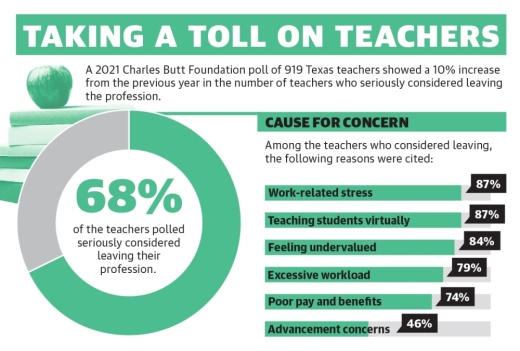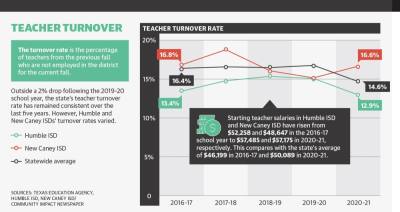Additionally, roughly 11.6% of the 2020-21 workforce—or about 42,800 teachers—had left the profession by the end of the school year, which is nearly 9,000 more than the previous year, TEA data shows.
Bob Popinski—senior director of policy at Raise Your Hand Texas, a statewide nonprofit that supports public policy solutions for the state’s education system—pointed to low teacher pay as a primary factor for the declining workforce.
Despite across-the-board pay raises for teachers stipulated in Texas House Bill 3—a sweeping school finance bill approved by the Legislature in 2019—new teachers are on average making less money than they were a decade ago when adjusted for inflation, Popinksi said.
"When the purchasing power for a teacher ... is less than it was 10 years ago by $1,000 or so, that creates a problem when you have other opportunities, so teachers are considering other professions,” Popinski said.
Going into the 2021-22 school year, New Caney ISD needed to hire an additional 180 teachers to meet the needs of its students, according to Trina Persson, the district’s director of recruitment and retention.
“We started seeing changes in the job market ... two years ago, and I thought, ‘Oh this is never going to reach education,’” Persson said. “Boy was I surprised when I started seeing the numbers at job fairs ... beginning to decline.”
Meanwhile, Humble ISD had roughly 60 teaching positions that went unfilled in the 2021-22 school year due to a lack of qualified candidates, HISD Chief Communications Officer Jamie Mount said.
While local educators said the issue has been exacerbated by the pandemic, the state’s teacher shortage existed beforehand. From 2010-19, the number of teachers initially certified—which does not include new certifications for teachers who already hold a teaching license—fell by about 20%, according to a 2021 University of Houston teacher workforce report.
Local experts said the issue can be attributed, in part, to low pay, but they also said some alternative certification programs and work-related stresses have also played a role in the declining workforce.
Teacher burnout
In a 2021 poll of 919 Texas teachers conducted by the Charles Butt Foundation, a statewide nonprofit that aims to promote educational equity, 68% said they seriously considered leaving the profession in 2021—a 10% increase from 2020.
Popinski said much of that increase can be attributed to the social and emotional toll taken on by teachers while providing remote instruction during the pandemic.
“After COVID[-19], not only are [teachers] looking after the social and emotional needs of 5.4 million kids in the state, but they also have their own social and emotional needs,” he said.
According to the poll, 77% of the teachers who considered leaving the profession cited supporting students’ well-being as a factor.
Adam Gorelick, who taught high school math in both New Caney and Spring ISDs before leaving the profession earlier this year, said he was often made to feel as if he was responsible for his students’ emotional needs.
“It was bad before the pandemic, but then the pandemic made it unbelievably horrible,” he said. “If a kid has social and emotional problems, ... they have people who are licensed professionals for that—not teachers.”
Tiffany Needham, executive director of the Houston branch of Teach for America, said she believes school districts need to better manage teachers’ time and resources.
“When you’re teaching six periods a day with a 40-minute break and then during that 40-minute break, you have to use the restroom, plan your lessons for the week [and] collaborate with your other teachers, it just doesn’t really work,” Needham said. “We wouldn’t really expect that from most other professionals.”
Alternative certifications
Texas is home to 129 educator preparation programs, including standard programs, which are typically offered by universities; post-baccalaureate programs and alternative certification programs.
In the 2020-21 school year, nearly 50% of teachers received their certification through an alternative program, according to TEA data.
Alternative certification programs, such as iteachTEXAS and Teach for America, provide a nontraditional, typically less expensive route for those who did not go through standard programs to obtain a teaching certificate, according to the TEA.
TEA data shows roughly 60% of educators who went through alternative certification programs in the 2015-16 school year remained in the profession after five years. This compares to roughly 70% of standard certified teachers who remained in the classroom after five years.
Amber Thompson, director of education for the University of Houston’s College of Education, said some alternative certification programs are conducted online and do not always require in-person classroom training.
“In order to be able [to teach] well and be prepared for it, you have to spend time working alongside a mentor teacher,” Thompson said, noting she believes state legislators should revisit the requirements for alternative certification programs to require more clinical training.
However, CaLandra Pervis, chair for Lone Star College-Kingwood’s education department, said many alternative certification programs, including the program offered at LSC-Kingwood, require as much or more in-person classroom training than some standard programs.
Pervis said students enrolled in LSC-Kingwood’s educator preparation program are required to complete one semester of clinical teaching, noting the college’s partnership with Texas Tech University requires a full year in the classroom.
Local solutions
Despite boasting a 98% teacher fill rate, HISD officials are still actively pursuing new ways to attract and retain teachers.
Deputy Superintendent Rick Gardner told HISD trustees at an April 19 budget workshop HISD is considering an initiative that would pay student teachers $60 per day, or roughly $11,000 per year.
Additionally, HISD Chief Financial Officer Billy Beattie said the district is also considering a proposal that would cover the cost of paraprofessionals pursuing alternative certifications.
HISD is proposing a 3% raise for all employees in the fiscal year 2022-23 budget, which would increase a new teacher’s annual salary from $59,000 to $60,500 for the 2022-23 school year.
“That allows us to remain competitive still with neighboring districts to be able to attract and retain the best staff possible,” Beattie said.
Mount also said HISD’s decision to provide its own health insurance plan instead of insurance through the Teacher Retirement System of Texas, known as TRS-ActiveCare, has allowed the district to avoid raising premium costs for its employees.
In April, NCISD trustees approved an employee compensation package for the 2022-23 school year that will include a one-time $2,000 stipend for all employees as well as an additional stipend for all returning employees, although an amount has yet to be determined.
According to Persson, NCISD’s academic calendar—which includes four five-day breaks in addition to a 10-day break in December—has helped attract employees to the district.
Persson said the district offers competitive stipends for harder-to-staff departments as well as scholarship programs for employees seeking continuing education opportunities.
“Any department—any employee—can apply for those scholarships,” she said. “We just want to support our employees as they move forward in their education journey.”








